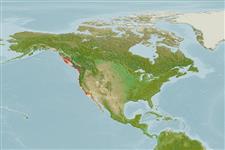Common names from other countries
>
Ovalentaria/misc (Various families in series Ovalentaria) >
Embiotocidae (Surfperches)
Etymology: Embiotoca: Greek, embios = permanent, for all the life + Greek, tokos,-oy = birth (Ref. 45335); lateralis: lateralis meaning lateral - referring to its blue stripes (Ref. 6885).
More on author: Agassiz.
Environment: milieu / climate zone / depth range / distribution range
Ökologie
seewasser demersal; tiefenbereich ? - 21 m (Ref. 2850). Subtropical; 58°N - 29°N, 138°W - 115°W
Eastern Pacific: Wrangell, southeastern Alaska to Point Cabras, northern Baja California, Mexico.
Size / Gewicht / Alter
Maturity: Lm ? range ? - ? cm
Max length : 38.0 cm TL Männchen/unbestimmt; (Ref. 2850); max. veröff. Alter: 10 Jahre (Ref. 56049)
Rückenflossenstacheln (insgesamt): 10 - 11; Rückenflossenweichstrahlen (insgesamt): 23-25; Afterflossenstacheln 3; Afterflossenweichstrahlen: 29 - 33. Copper ground color with dark brown overlay on back; a series of about 15 blue horizontal stripes below lateral line; head with several series of blue spots and stripes; fins coppery; dark areas on anterior part of rayed dorsal, base of caudal fin, anterior part of anal, and distal halves of pelvic fins (Ref. 6885).
Adults occur in rocky coasts and kelp beds, occasionally in sandy surf near rocks (Ref. 2850). Feed on small crustaceans, worms, and mussels; occasionally on herring eggs (Ref. 4925). Viviparous, female carries the developing young (Ref. 205).
Viviparous, female carries the developing young (Ref. 205).
Eschmeyer, W.N., E.S. Herald and H. Hammann, 1983. A field guide to Pacific coast fishes of North America. Boston (MA, USA): Houghton Mifflin Company. xii+336 p. (Ref. 2850)
IUCN Rote Liste Status (Ref. 130435)
CITES (Ref. 128078)
Not Evaluated
Bedrohung für Menschen
Harmless
Nutzung durch Menschen
Fischereien: kommerziell; Sportfisch: ja; Aquarium: Öffentliche Aquarien
Mehr Information
ReferenzenAquakulturAquakultur ProfilZuchtlinienGenetikElectrophoresesVererbbarkeitKrankheitenVerarbeitungMass conversion
Tools
Zusatzinformationen
Download XML
Internet Quellen
Estimates based on models
Preferred temperature (Ref.
115969): 9.3 - 15.4, mean 10.7 (based on 149 cells).
Phylogenetic diversity index (Ref.
82804): PD
50 = 0.7500 [Uniqueness, from 0.5 = low to 2.0 = high].
Bayesian length-weight: a=0.01905 (0.00831 - 0.04372), b=2.97 (2.77 - 3.17), in cm Total Length, based on LWR estimates for this (Sub)family-body shape (Ref.
93245).
Trophic level (Ref.
69278): 3.3 ±0.49 se; based on food items.
Widerstandsfähigkeit (Ref.
120179): mittel, Verdopplung der Population dauert 1,4 - 4,4 Jahre. (tm=3; tmax=10).
Fishing Vulnerability (Ref.
59153): Low to moderate vulnerability (28 of 100).
